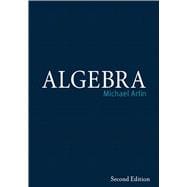
1. Matrices
1.1 The Basic Operations
1.2 Row Reduction
1.3 The Matrix Transpose
1.4 Determinants
1.5 Permutations
1.6 Other Formulas for the Determinant
1.7 Exercises
2. Groups
2.1 Laws of Composition
2.2 Groups and Subgroups
2.3 Subgroups of the Additive Group of Integers
2.4 Cyclic Groups
2.5 Homomorphisms
2.6 Isomorphisms
2.7 Equivalence Relations and Partitions
2.8 Cosets
2.9 Modular Arithmetic
2.10 The Correspondence Theorem
2.11 Product Groups
2.12 Quotient Groups
2.13 Exercises
3. Vector Spaces
3.1 Subspaces of Rn
3.2 Fields
3.3 Vector Spaces
3.4 Bases and Dimension
3.5 Computing with Bases
3.6 Direct Sums
3.7 Infinite-Dimensional Spaces
3.8 Exercises
4. Linear Operators
4.1 The Dimension Formula
4.2 The Matrix of a Linear Transformation
4.3 Linear Operators
4.4 Eigenvectors
4.5 The Characteristic Polynomial
4.6 Triangular and Diagonal Forms
4.7 Jordan Form
4.8 Exercises
5. Applications of Linear Operators
5.1 Orthogonal Matrices and Rotations
5.2 Using Continuity
5.3 Systems of Differential Equations
5.4 The Matrix Exponential
5.5 Exercises
6. Symmetry
6.1 Symmetry of Plane Figures
6.2 Isometries
6.3 Isometries of the Plane
6.4 Finite Groups of Orthogonal Operators on the Plane
6.5 Discrete Groups of Isometries
6.6 Plane Crystallographic Groups
6.7 Abstract Symmetry: Group Operations
6.8 The Operation on Cosets
6.9 The Counting Formula
6.10 Operations on Subsets
6.11 Permutation Representation
6.12 Finite Subgroups of the Rotation Group
6.13 Exercises
7. More Group Theory
7.1 Cayley's Theorem
7.2 The Class Equation
7.3 r-groups
7.4 The Class Equation of the Icosahedral Group
7.5 Conjugation in the Symmetric Group
7.6 Normalizers
7.7 The Sylow Theorems
7.8 Groups of Order 12
7.9 The Free Group
7.10 Generators and Relations
7.11 The Todd-Coxeter Algorithm
7.12 Exercises
8. Bilinear Forms
8.1 Bilinear Forms
8.2 Symmetric Forms
8.3 Hermitian Forms
8.4 Orthogonality
8.5 Euclidean spaces and Hermitian spaces
8.6 The Spectral Theorem
8.7 Conics and Quadrics
8.8 Skew-Symmetric Forms
8.9 Summary
8.10 Exercises
9. Linear Groups
9.1 The Classical Groups
9.2 Interlude: Spheres
9.3 The Special Unitary Group SU 2
9.4 The Rotation Group SO 3
9.5 One-Parameter Groups
9.6 The Lie Algebra
9.7 Translation in a Group
9.8 Normal Subgroups of SL 2
9.9 Exercises
10. Group Representations
10.1 Definitions
10.2 Irreducible Representations
10.3 Unitary Representations
10.4 Characters
10.5 One-Dimensional Characters
10.6 The Regular Representations
10.7 Schur's Lemma
10.8 Proof of the Orthogonality Relations
10.9 Representationsof SU 2
10.10 Exercises
11. Rings
11.1 Definition of a Ring
11.2 Polynomial Rings
11.3 Homomorphisms and Ideals
11.4 Quotient Rings
11.5 Adjoining Elements
11.6 Product Rings
11.7 Fraction Fields
11.8 Maximal Ideals
11.9 Algebraic Geometry
11.10 Exercises
12. Factoring
12.1 Factoring Integers
12.2 Unique Factorization Domains
12.3 Gauss's Lemma
12.4 Factoring Integer Polynomial
12.5 Gauss Primes
12.6 Exercises
13. Quadratic Number Fields
13.1 Algebraic Integers
13.2 Factoring Algebraic Integers
13.3 Ideals in Z √(-5)
13.4 Ideal Multiplication
13.5 Factoring Ideals
13.6 Prime Ideals and Prime Integers
13.7 Ideal Classes
13.8 Computing the Class Group
13.9 Real Quadratic Fields
13.10 About Lattices
13.11 Exercises
14. Linear Algebra in a Ring
14.1 Modules
14.2 Free Modules
14.3 Identities
14.4 Diagonalizing Integer Matrices
14.5 Generators and Relations
14.6 Noetherian Rings
14.7 Structure to Abelian Groups
14.8 Application to Linear Operators
14.9 Polynomial Rings in Several Variables
14.10 Exercises
15. Fields
15.1 Examples of Fields
15.2 Algebraic and Transcendental Elements
15.3 The Degree of a Field Extension
15.4 Finding the Irreducible Polynomial
15.5 Ruler and Compass Constructions
15.6 Adjoining Roots
15.7 Finite Fields
15.8 Primitive Elements
15.9 Function Fields
15.10 The Fundamental Theorem of Algebra
15.11 Exercises
16. Galois Theory
16.1 Symmetric Functions
16.2 The Discriminant
16.3 Splitting Fields
16.4 Isomorphisms of Field Extensions
16.5 Fixed Fields
16.6 Galois Extensions
16.7 The Main Theorem
16.8 Cubic Equations
16.9 Quartic Equations
16.10 Roots of Unity
16.11 Kummer Extensions
16.12 Quintic Equations
16.13 Exercises
Appendix A. Background Material
A.1 About Proofs
A.2 The Integers
A.3 Zorn's Lemma
A.4 The Implicit Function Theorem
A.5 ExercisesThe New copy of this book will include any supplemental materials advertised. Please check the title of the book to determine if it should include any access cards, study guides, lab manuals, CDs, etc.
The Used, Rental and eBook copies of this book are not guaranteed to include any supplemental materials. Typically, only the book itself is included. This is true even if the title states it includes any access cards, study guides, lab manuals, CDs, etc.